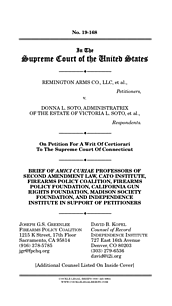Learn more about Cato’s Amicus Briefs Program.
In 2005, Congress passed the bipartisan Protection of Lawful Commerce in Arms Act (PLCAA) by a nearly two-thirds margin. PLCAA’s purpose was to curb efforts by gun-control advocates to circumvent state legislatures and attack Second Amendment rights through a never-ending series of lawsuits against manufacturers and retailers of firearms to hold them financially responsible for crimes committed using the weapons they make and sell. Although the dubious legal theories behind these lawsuits only rarely resulted in verdicts against manufacturers and retailers, the mounting costs of the lawsuits began to run gun makers and sellers out of business. Litigation-induced bankruptcy, it turned out, was an effective way of restricting Americans’ ability to exercise their Second Amendment right to keep and bear arms. Congress passed the PLCAA to end that abuse of the judicial system, providing firearm manufacturers and retailers with immunity against legal claims resulting from the criminal use of their products.
Despite PLCAA’s protections, in 2014 victims of the mass shooting at Sandy Hook Elementary School and their family members attempted to hold Remington, a gun manufacturer, responsible for the crimes of the killer because the rifle he used was made by Remington. They argued that the killer chose the Remington rifle from his mother’s legally owned collection of guns because Remington’s advertisements for the rifle connect it with the military, a subject the killer was interested in. The lawsuit claims these advertisements constitute an “unfair trade practice” under Connecticut law and therefore fit into a narrow exception to PLCAA’s protection. This exception applies only when sellers violate a law regulating the sale or marketing of their products and that violation leads to a crime committed with a gun they sell. The evidence shows, however, that Congress didn’t intend this exception to apply to lawsuits based on vague claims of “unfair trade practices.” In fact, this is exactly the type of lawsuit the PCLAA was intended to prohibit. A sharply divided Connecticut Supreme Court, however, decided that the exception applied and allowed Remington to be sued.
Remington is now petitioning the U.S. Supreme Court to review the Connecticut decision and restore the scope of PCLAA’s protections to what Congress intended. Cato, together with the Firearms Policy Coalition, the Firearms Policy Foundation, the Madison Society Foundation, the Independence Institute, and a coalition of law professors, has filed a brief in support of Remington’s petition. We argue that lawsuits like this one are not a new phenomena—drowning political opponents in litigation costs to restrict the exercise of constitutional rights is the same strategy that opponents of the Civil Rights movement used to prevent newspapers from exposing abuses in the Jim Crow South. In 1964, the Supreme Court stepped in to halt these abusive lawsuits and protect the press’s ability to exercise its First Amendment rights in the landmark case of New York Times v. Sullivan. Just as the Supreme Court protected First Amendment rights against abusive suits in Sullivan, Congress protected Second Amendment rights against abusive suits with the PCLAA. Remington is now asking the Supreme Court to give the PCLAA a fair interpretation and prevent it from becoming a dead-letter.
In Sullivan, the Court understood that newspapers exercising their First Amendment rights were being sued under vague and amorphous legal standards. Lawsuits that attempt to hold firearms manufacturers liable for gun crimes based solely on advertisements that evoke themes common in American arms culture, such as self-defense and the military, are similarly problematic. Firearms manufacturers have a First Amendment right to advertise their products with imagery and themes that have a close relationship with the exercise of Second Amendment rights. Congress passed the PCLAA to safeguard these rights. We urge the Court to support Congress’s efforts to protect Americans’ constitutional rights by restoring the full scope of PCLAA’s protection.

This work is licensed under a Creative Commons Attribution-NonCommercial-ShareAlike 4.0 International License.
